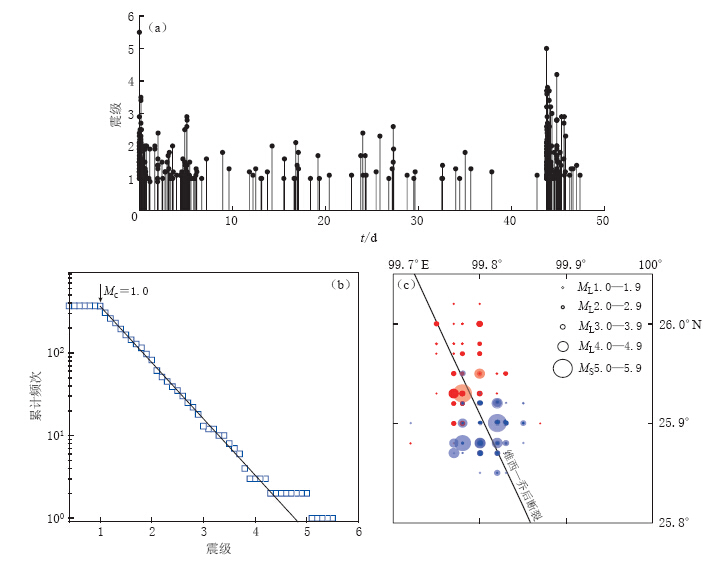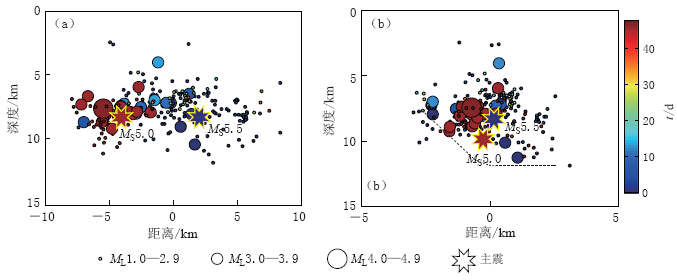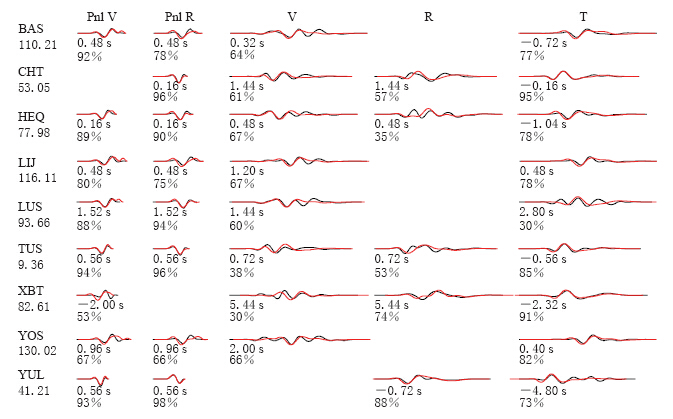Seismogenic structure identification of the 2013 Eryuan MS5.5 and MS5.0 earthquake sequence
-
摘要: 采用Hypo2000和双差定位方法对2013年云南洱源MS5.5和MS5.0地震序列进行了重新定位. 结果显示: 精定位后洱源地震序列分布优势方向集中在160°; 用CAP方法反演了两次5级地震震源机制, 节面Ⅱ的走向158°和157°与余震优势分布方向一致; 现场考察MS5.5和MS5.0地震极震区的长轴方向也是NW向. 上述结果与维西—乔后断裂NNW走向一致, 据此判定该断裂为洱源MS5.5和MS5.0地震的发震构造. 序列震源机制解显示, 洱源地震序列表现出不同的错断性质以及不同方向主压应力, 可能与维西—乔后断裂所处区域复杂构造应力场有关.Abstract: The Eryuan MS5.5 and MS5.0 earthquake sequence are relocated by using absolute location (Hypo2000) and double-difference earthquake location (HypoDD) methods. The results show that the dominant direction of relocated aftershocks concentrated at 160°. Focal mechanisms of the MS5.5 and MS5.0 earthquakes are inverted by CAP method. The inversion result shows that the strike angles of the nodal plane Ⅱ were 158° and 157°, respectively, which are consistent with dominant distribution direction of aftershocks. Field survey suggests that the major axis of the meizoseismal region was also in NW direction. The above three directions were consistent with the NNW strike orientation of Weixi--Qiaohou fault, which can be considered as the seismogenic structure of the Eryuan earthquake sequence. Focal mechanisms of the sequence indicate that different focal dislocations and different orientations of principal compression stresses, may have relationship with the complex regional structural stress field of Weixi--Qiaohou fault.
-
-
图 1 洱源地震序列M-t图(a)、 目录完整性分析(b)和精定位前序列震中分布图(c)
图(a)中横坐标为距离2013年3月3日洱源MS5.5地震天数; 图(b)中正方形为累计 频度,斜线为累计频度-震级最大似然法拟合曲线; 图(c)中红色圆为3月3日洱源 MS5.5及其后续地震,蓝色圆为4月17日洱源MS5.0及其后续地震
Figure 1. M-t diagram of Eryuan earthquake sequence; (b) Completeness of earthquake catalogues; (c) Epicentral distribution of Eryuan sequence before accurate location
The x-axis in Fig.(a) means the days from Eryuan MS5.5 earthquake on March 3, 2013; squares in Fig.(b) are accumulative frequency, the black line is accumulative frequency-magnitude fitting curve using maximum likelihood method; in Fig.(c) red circles are the epicenters of MS5.5 and its following shocks, blue circles are those of MS5.0 and its following shocks
图 2 精定位后洱源地震序列(a)和震中分布(b)图
实心圆表示余震震中,红色星表示主震震中位置. 色标表示距离两次5级地震发震时刻 的时间差. AB为沿着维西—乔后断裂的剖面,CD为垂直于该断裂的剖面
Figure 2. The epicentral distribution of the Eryuan earthquake sequence after accurate location
Solid circles denote epicenters of aftershocks; red stars mean epicenters of the main shocks; the color scale represents the difference of occurrence times between two main shocks. AB is the section along the Weixi-Qiaohou fault, and CD is the section perpendicular to the fault
图 5 洱源MS5.5地震的理论地震波形(红色)与实际观测地震波形(黑色)
波形下面第一行数字为理论地震图相对观测地震图的移动时间; 第二行数字为二者的相关系数; 波形 左侧的字母和数字分别为台站名称和震中距(km); 图中V表示垂直向,R表示径向,T表示切向
Figure 5. Comparison between synthetic (red) and observed (black) seismograms of Eryuan MS5.5 earthquake
Numbers in the first line below the waveform curves are the time shifts(in unit of s)between the two kinds of seismograms, and those in the second lines are correlation coefficients of the theoretical and observed seismograms; station’s symbol and its distance are given on the left of each line of the waveforms,respectively
图 7 2013年洱源地震序列主震位置及其震源机制解、 烈度及台站分布图
① 维西—乔后断裂; ② 红河断裂; ③ 程海断裂; ④ 龙蟠—乔后断裂; ⑤ 澜沧江断裂; ⑥ 怒江断裂
Figure 7. Distribution of 2013 Eryuan main shocks,focal mechanism solutions, seismic intensity and seismographic stations
① Weixi-Qiaohou fault; ② Honghe fault; ③ Chenghai fault; ④ Longpan-Qiaohou fault; ⑤ Lancangjiang fault; ⑥ Nujiang fault
图 8 洱源地震序列优势分布方位(a)和确定序列余震优势分布方位示意图(b)
星号为示意性的主震位置,θ含义参见正文
Figure 8. The dominant distribution orientation of Eryuan earthquake sequence(a) and schematic diagram for determination of the sequence dominant distribution orientation(b)
The star denotes the main shock location,the meaning of θ can be found in this paper
表 1 本文与GCMT、 CEA-IGP得到的震源机制解比较
Table 1 A comparison among focal mechanism solutions from this study, GCMT and CEA-IGP

表 2 洱源地区分层地壳速度模型
Table 2 Layered crustal velocity model for Eryuan region

表 3 2013年洱源地震序列震源机制解
Table 3 Focal mechanism solutions of Eryuan earthquake sequences in 2013

-
崔效锋, 谢富仁, 张红艳. 2006. 川滇地区现代构造应力场分区及动力学意义[J]. 地震学报, 28(5): 451-461. Cui X F, Xie F R, Zhang H Y. 2006. Recent tectonic stress field zoning in Sichuan-Yunnan region and its dynamic interest[J]. Acta Seismologica Sinica, 28(5): 451-461 (in Chinese).
顾浩鼎, 陈运泰, 高祥林, 赵毅. 1976. 1975年2月4日辽宁省海城地震的震源机制[J]. 地球物理学报, 19(4): 274-284. Gu H D, Chen Y T, Gao X L, Zhao Y. 1976. Focal mechanism of Haicheng, Liaoning Province, earthquake of February 4, 1975[J]. Acta Geophysica Sinica, 19(4): 274-284 (in Chinese).
韩立波, 蒋长胜, 包丰. 2012. 2010年河南太康MS4.6地震序列震源参数的精确确定[J]. 地球物理学报, 55(9): 2973-2981. Han L B, Jiang C S, Bao F. 2012. Source parameter determination of 2010 Taikang MS4.6 earthquake sequences[J]. Chinese Journal of Geophysics, 55(9): 2973-2981 (in Chinese).
贺传松, 王椿镛, 吴建平. 2004. 用远震接收函数研究滇西地区的深部结构[J]. 地震学报, 26(3): 238-246. He C S, Wang C Y, Wu J P. 2004. A study on deep structure using teleseismic receiver function in western Yunnan[J]. Acta Seismologica Sinica, 26(3): 238-246 (in Chinese).
何志桐, 谢挺. 1977. 邢台地震系列空间分布、 构造应力场及其发生过程的探讨[J]. 地球物理学报, 20(2): 131-141. He Z T, Xie T. 1977. The hypocentral distribution of the Xingtai earthquake series, tectonic stress field and the process of earthquake ocurrences[J]. Acta Geophysica Sinica, 20(2): 131-141 (in Chinese).
胡鸿翔, 陆涵行, 王椿镛, 何正勤, 朱良保. 1986. 滇西地区地壳结构的爆破地震研究[J]. 地球物理学报, 29(2): 133-144. Hu H X, Lu H X, Wang C Y, He Z Q, Zhu L B.1986. Explosion investigation of the crustral structure in western Yunnan Province[J]. Acta Geophysica Sinica, 29(2): 133-144 (in Chinese).
李轶群, 王健. 2008. 唐山余震区中小地震震源机制解分区特征的初步研究[J]. 中国地震, 24(2): 150-158. Li Y Q, Wang J. 2008. The preliminary study on focal mechanism of small and moderate earthquakes in divided zones around Tangshan[J]. Earthquake Research in China, 24(2): 150-158 (in Chinese).
李永华, 吴庆举, 田小波, 张瑞青, 潘佳铁, 曾融生.2009.用接收函数方法研究云南及其邻区地壳上地幔结构[J]. 地球物理学报, 52(1): 67-80. Li Y H, Wu Q J, Tian X B, Zhang R Q, Pan J T, Zeng R S. 2009. Crustal structure in the Yunnan region determined by modeling receiver functions[J]. Chinese Journal of Geophysics, 52(1): 67-80 (in Chinese).
龙锋, 张永久, 闻学泽, 倪四道, 张致伟. 2010. 2008年8月30日攀枝花-会理6.1级地震序列ML≥4.0事件的震源机制解[J]. 地球物理学报, 53(12): 1-9. Long F, Zhang Y J, Wen X Z, Ni S D, Zhang Z W. 2010. Focal mechanism solutions of ML≥4.0 events in the MS6.1 Panzhihua-Huili earthquake sequence of Aug 30, 2008[J]. Chinese Journal of Geophysics, 53(12): 1-9 (in Chinese).
罗艳, 倪四道, 曾祥方, 郑勇, 陈棋福, 陈颙. 2010. 汶川地震余震区东北端一个余震序列的地震学研究[J]. 中国科学: 地球科学, 40(6): 677-687. Luo Y, Ni S D, Zeng X F, Zheng Y, Chen Q F, Chen Y. 2010. A shallow aftershock sequence in the north-eastern end of the Wenchuan earthquake aftershock zone[J]. Scientia Sinica Terrae, 40(6): 677-687 (in Chinese).
马文涛, 徐锡伟, 曹忠权, 于贵华, 李海鸥, 徐长朋. 2008. 震源机制解分类与川滇及邻近地区最新变形特征[J]. 地震地质, 30(4): 926-934. Ma W T, Xu X W, Cao Z Q, Yu G H, Li H O, Xu C P. 2008. Classification of focal mechanism solutions and characteristics of latest crustal deformation of Sichuan-Yunnan region and its adjacency[J]. Seismology and Geology, 30(4): 926-934 (in Chinese).
王绍晋, 于利民, 李钦祖. 1991. 利用P、 S振幅比资料测定澜沧-耿马震区中、 小地震震源机制[J]. 地震研究, 14(3): 195-202. Wang S J, Yu L M, Li Q Z. 1991. The source mechanism of moderate and small events determined by P and S amplitude ratio on Lancang-Gengma earthquake area[J]. Journal of Seismological Research, 14(3): 195-202 (in Chinese).
魏柏林. 1980. 余震震源机制变化的原因[J]. 地球物理学报, 23(1): 25-34. Wei B L. 1980. Cause of the change of focal mechanisms of aftershocks[J]. Acta Geophysica Sinica, 23(1): 25-34 (in Chinese).
魏柏林, 刘特培, 陈玉桃. 2011. 汶川余震震源机制变化的原因[J]. 华南地震, 31(4): 62-69. Wei B L, Liu T P, Chen Y T. 2011. Cause of the change of focal mechanisms of Wenchuan aftershocks[J]. South China Journal of Seismology, 31(4): 62-69 (in Chinese).
韦生吉, 倪四道, 崇加军, 郑勇, 陈颙. 2009. 2003年8月16日赤峰地震: 一个可能发生在下地壳的地震? [J]. 地球物理学报, 52(1): 111-119. Wei S J, Ni S D, Chong J J, Zheng Y, Chen Y. 2009. The August 2003 Chifeng earthquake: Is it a lower crust earthquake? [J]. Chinese Journal of Geophysics, 52(1): 111-119 (in Chinese).
吴建平, 明跃红, 王椿镛. 2004. 云南地区中小地震震源机制及构造应力场研究[J]. 地震学报, 26(5): 457-465. Wu J P, Ming Y H, Wang C Y. 2004. Source mechanism of small-to-moderate earthquakes and tectonic stress field in Yunnan Province[J]. Acta Seismologica Sinica, 26(5): 457-465 (in Chinese).
谢富仁, 刘光勋, 梁海庆. 1994. 滇西北及邻区现代构造应力场[J]. 地震地质, 16(4): 329-338. Xie F R, Liu G X, Liang H Q. 1994. Recent tectonic stress field in northwest Yunnan Province and its adjacent areas[J]. Seismology and Geology, 16(4): 329-338 (in Chinese).
易桂喜, 龙锋, 张致伟. 2012. 汶川MS8.0地震余震震源机制时空分布特征[J]. 地球物理学报, 55(4): 1213-1227. Yi G X, Long F, Zhang Z W. 2012. Spatial and temporal variation of focal mechanisms for aftershocks of the 2008 MS8.0 Wenchuan earthquaks[J]. Chinese Journal of Geophysics, 55(4): 1213-1227 (in Chinese).
郑勇, 马宏生, 吕坚, 倪四道, 李迎春, 韦生吉. 2009. 汶川地震强余震(MS≥5.6)的震源机制解及其与发震构造的关系[J]. 中国科学: D辑, 39(4): 413-426. Zheng Y, Ma H S, Lü J, Ni S D, Li Y C, Wei S J. 2009. Source mechanism of strong aftershock (MS≥5.6) of the 2008/05/12 Wenchuan earthquake and the implication for seismotectonics[J]. Science in China: Series D, 39(4): 413-426 (in Chinese).
钟大赉. 1998. 滇川西部古特提斯造山带[M]. 北京: 科学出版社: 71-77. Zhong D L.1998. Paleo-Tethys Orogen of Western Yunnan and Sichuan Provinces[M]. Beijing: Science Press: 71-77 (in Chinese).
Klein F W. 1978. Hypocenter Location Program HYPOINVERSE Part I: Users Guide to Versions 1, 2, 3 and 4[CP]. U S Geol Surv Open-File Rept: 78-694.
Lutz T M. 1986. An analysis of the orientations of large-scale crustal structures: A statistical approach based on areal distributions of pointlike features[J]. J Geophys Res, 91(B1): 421-434.
Lutz T M, Gutmann J T. 1995. An improved method for determining and characterizing alignments of pointlike features and its implications for the Pinacate volcanic field, Sonora, Mexico[J]. J Geophys Res, 100(B9): 17659-17670.
Waldhauser F, Ellsworth W L. 2000. A double-difference earthquake location algorithm: Method and application to the Northern Hayward Fault, California[J]. Bull Seismol Soc Am, 90(6): 1353-1368.





 下载:
下载:







